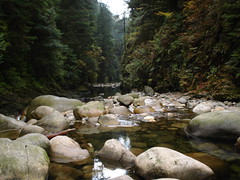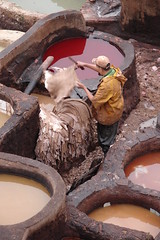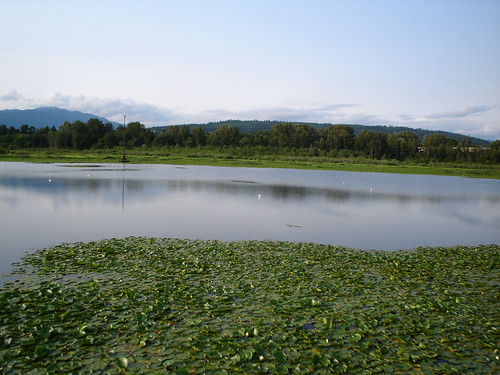As I mentioned, I was invited by Doug Van Spronsen and Jered Love from WaterDrop to give a keynote talk at their inaugural event “The Global Water Crisis”. I am both honored and flattered that they invited me to their first event, and I do hope I contributed to the discussions we had.
What follows below my slides (hosted on Slide Share under a Creative Commons License – Non-Commercial, Attribution, Share-Alike) is an unedited crib of my talk. I borrow the term “crib” from Dr. danah boyd (who is a scholar of social media and youth) who publishes unedited typed notes of her talks and calls them crib. A crib of her latest research can be found here.
Good evening, and thank you everyone for coming. Thanks, first of all, to Doug and Jered for inviting me. I am very honored and flattered to be speaking to such an engaged group of citizens. I hope my talk will provide you with a quick overview of the way in which I think about water issues, and hopefully, you’ll learn some interesting stuff about water.
I have come to admit recently that I am a story teller. My research tells you a story. The story I’m interested in telling you has to do with my interest in questions of access to clean water and sanitation. I approach water problems from an interdisciplinary perspective, and while my PhD is interdisciplinary, I have a strong bias towards the social sciences. However, I also have an MBA and a chemical engineering background so I look at these issues from a variety of lenses.
If I had to summarize my research in a sentence, I can tell you that I have found tthat while we have the technology to treat water and recycle it (thus reducing the amount of water wasted) we don’t have the institutional arrangements to facilitate the adoption of these wastewater treatment technologies.
There is a reason why I always start my talks on water with a photograph like the one you are seeing on the cover slide. Yes, that is a photo of people collecting water in Sub-Saharan Africa. That is the quality of water these people are consuming. As you saw in the powerful documentary, Flow, there is a huge demand for clean drinking water in many developing countries. My work aims to contribute to increasing access to better water quality globally.
In the environmental public policy literature (and in every element of human life) we always have two elements: the politics and the policy. I confess that I practice a politics of fear, and a policy of hope. My notion of politics of fear means that I am more than happy to scare people with data. I have no qualms in scaring people and showing them the realities of environmental degradation. However, I am also a practitioner and an activist in some ways. Therefore, I practice a policy of hope. I offer potential technical and policy solutions. I also educate, not only my students, but everybody who will listen to me, about the need to look at water issues and not forget about how important they are in the light of current focus on climate change issues. We live in an interconnected world, so we must look at water issues as part of the global environmental change challenges.
Throughout my talk, I will share some terrifying facts that I hope will galvanize you to take action. And then I will close my talk by offering a few policy suggestions and highlighting the issues that need to be talked about. My hope is that after my talk, you will be compelled to engage in action to examine your own water consumption patterns and make substantial changes (for the good of humanity)
SLIDES 3 AND 4 – 3,900 children die every day from water-borne diseases. Nearly 41% of the world’s population lives in river basins under water stress. Less than 0.3% of the world’s water is freshwater. Less than 3% of the world’s water supply is available in lakes and rivers. With those facts, do you still feel compelled to take long showers, leave your tap open while brushing your teeth, wash the streets with the water hose? I sure hope not!
SLIDES 5 AND 6 – I love dispelling myths. That’s what made doing my doctoral research and my post-doctoral work so much fun. I enjoy shattering myths, like the one of Canada’s water abundance. If you juxtapose the graphs of water availability and water withdrawal, you’ll see that while Canada has a lot of water available (range of 1,700-5,00 m3/person/year) it also withdraws a lot of water (1,700 m3/person/year). If you do the math correctly, you’ll find that we will soon be in a negative water balance. As you can see, taken individually, these two graphs paint very different pictures. But that’s why we need to think about environmental problems in a holistic way. Canada is one of the countries with the highest water withdrawal rates (Slide 6). We need to re-think the way we approach water consumption and treatment.
Given my empirical research focus on Mexico (a country with one of the highest consumption rates by agricultural activities), it was somewhat shocking for me to find data indicating that in comparison, one (if not THE) main use of water in Canada is in energy production. (SLIDE 7).
There are numerous myths that I could dispel about the state of Canadian water, and numerous issues that need to be taken into account but have not. However, I am just going to highlight two (SLIDE 8). The first one is the rate of average daily water use in the residential sector. As you can see, it has been consistently in the vicinity of 300 litres per capita per day. The daily consumption of water in Africa is 10-20 litres per person per day. Canadians use between 15 and 20 times that. Time to re-think our consumptive patterns. The second graph shows the percentage of municipal population in sewers. Not 100%, as you can see. Well below. We need much more infrastructure for wastewater and sewerage.
SLIDE 9 – One of my most extensive research projects has been in the governance of wastewater and sanitation. This map shows you the distribution of wastewater facilities in Canada. I am currently working on launching a project to examine the state of wastewater policy across Canada, and I am hoping to use this as a baseline. Just for comparative purposes, Canada has less wastewater treatment facilities than the Lerma-Chapala river basin in Mexico does. Rather surprising, eh? In many ways, Canada’s state of sanitation wastewater and infrastructure appears to be much worse than Mexico.
SLIDE 10 – I will admit that I am a big proponent of water metering and water pricing as a policy mechanism to reduce water overconsumption and waste. I do not adhere to the idea of the commodification of water, and I confess that I still need to do more research on privatization of water supplies to define my position. But I am a firm believer that water should NOT be wasted. And I think that putting a price on water and measuring the supply will definitely help minimize excessive withdrawals. If you pay for it, you’ll think twice about wasting it. From the graph you can see that Canada has the cheapest cost of water ($ 0.31/cubic metre vs. $2.36/cubic metre in Germany). Again, time to re-think our consumptive patterns.
SLIDE 11 – I’m going to turn now to three tools that have helped me re-think the way I approach water problems. The first one is the concept of water stress. I have written on water stress previously on my blog, and I just want to show you that there are MANY areas all over North America under high water stress. Canada included.
SLIDE 12 – The second concept I’ve been exploring is the idea of virtual water (I also recently wrote about virtual water on my blog). Virtual water is the amount of water embedded in food or other products needed. For example, to manufacture 1 cup of coffee, you need 140 litres. That cup of coffee you are downing every morning? Yes, 140 litres of water were used in it. Time to re-think our behavioral patterns. I have personally shifted my diet from primarily meat to primarily vegetarian (producing meat consumes way more resources than vegetables).
SLIDE 13 – Finally, the third concept I’ve been exploring is the idea of a water footprint. Similar to the term coined by Dr. Mathis Wackernagel and Dr. Bill Rees (coincidentally, Dr. Wackernagel and I obtained our PhDs from The University of British Columbia, albeit in different programmes. Also, I do know the work of Dr. Rees very well), the water footprint borrows the main conceptual framework from the ecological footprint. The water footprint of a nation is defined as the volume of water needed to produce goods and serices consumed by the inhabitants of the country. I have also written about water footprint on my blog, but not to a large extent. However, there is an actual blog where the authors disseminate their findings on water footprinting. You can read it here. You can guess, yes – one of the highest water footprints is that of the United States of America. Not shocking, eh? Canada is, sadly, lagging not much behind.
SLIDE 14 – I would like to begin closing my talk (I promised it’d be short!) by re-emphasizing the issues I’ve been talking about in my research in the past five years. We need to start focusing on ways to close the hydrological cycle. What do I mean by that? I mean that we need to start paying attention on the red arrows in the graph you are looking at right now in this slide (14). We need to consider how we are going to treat water to the quality level we need. We also need to ensure that when we talk about water, we don’t talk solely about access to water, but also access to sanitation facilities and wastewater treatment. If we treat more water, we can replenish our water bodies. However, of course, it would be smarter if we didn’t consume so much water and/or if we didn’t pollute it in the first place.
SLIDE 15 – Finally, as I promised, I’m going to give you hope. I think that the biggest hope I have is that the documentary you saw tonight, the talks that my fellow presenters and I gave, and the interaction you will most definitely have with the exhibitors in the back of the room (Council of Canadians, Oxfam, Township of Langley’s Water Wise) will shape how you will behave in regards to water from now on.
I hope that Canadian politicians and bureaucrats realize that we need a cohesive, coherent and smart and sound nation-wide water policy.
I hope that Canada improves in regards to its inventories of water and water balances.
I hope that everybody in Canada begins to think about water and the hydrological cycle in an integrated way.
And I hope that you learned something from my talk. Feel free to contact me via e-mail, Twitter or dropping a comment on my blog. I am always available for speaking engagements, to talk to students and the public, and to share whatever little I have learned in regards to environmental public policy and water governance.
THANK YOU.
 Discussions on whether Vancouver and other municipalities in Canada should ban bottled water have been predominant in the social discourse particularly in the past couple of years (2007-2009). Earlier this year, the Federation of Canadian Municipalities called for a ban in bottled water (mostly focusing on civic buildings and parks). Recently, legislation that effectively would eliminate sales of bottled water in Vancouver has apparently been under discussion, and the Vancouver Education Board seemingly has considered eliminating bottled water sales within schools. I have been puzzled about societal perceptions of drinking water in Canada for a while now. As a scholar of environmental politics, I am fascinated by the political aspects of new policy implementation. Banning bottled water at the municipal or regional level could potentially have negative implications as citizens would shift consumption from bottled water (a healthier alternative) to soft drinks. What kind of policy instruments and new legislation would our province/regional district require in order to encourage the proper shift in behavior (i.e. reduce plastic bottles in landfills, encourage consumption of tap water)? This is an interesting research problem.
Discussions on whether Vancouver and other municipalities in Canada should ban bottled water have been predominant in the social discourse particularly in the past couple of years (2007-2009). Earlier this year, the Federation of Canadian Municipalities called for a ban in bottled water (mostly focusing on civic buildings and parks). Recently, legislation that effectively would eliminate sales of bottled water in Vancouver has apparently been under discussion, and the Vancouver Education Board seemingly has considered eliminating bottled water sales within schools. I have been puzzled about societal perceptions of drinking water in Canada for a while now. As a scholar of environmental politics, I am fascinated by the political aspects of new policy implementation. Banning bottled water at the municipal or regional level could potentially have negative implications as citizens would shift consumption from bottled water (a healthier alternative) to soft drinks. What kind of policy instruments and new legislation would our province/regional district require in order to encourage the proper shift in behavior (i.e. reduce plastic bottles in landfills, encourage consumption of tap water)? This is an interesting research problem. 






Recent Comments